
Myrtle Hill Cemetery is the second oldest cemetery in the city of Rome, Georgia. The cemetery is at the confluence of the Etowah River and Oostanaula River and to the south of downtown Rome across the South Broad Street bridge.

Highway 136 is an east–west state highway in northeast Arkansas. The route of 7.87 miles (12.67 km) runs from Highway 135 near Rivervale east across Highway 140 to Highway 77 near Etowah.

The Blandford Church is the oldest building in Petersburg, Virginia whose history is well documented. It is at the highest point in the city, atop Well's Hill. It is today (2019) part of a memorial to Southern soldiers who died during the Civil War. It is adjacent to Blandford Cemetery, one of the oldest, largest and historically significant cemeteries in Virginia. The Blandford Cemetery did not exist until after the church building had been abandoned, in the early 1800s, and the land purchased by the city to use as a cemetery.
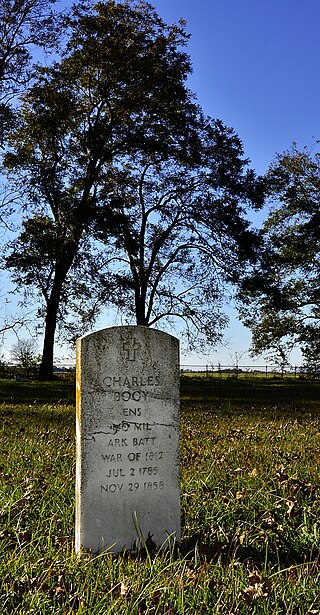
St. Peter's Cemetery is a historic rural cemetery in eastern Jefferson County, Arkansas. It is located east of Pine Bluff, Arkansas, on the south side of Morgan Drive, about 2 miles (3.2 km) west of Arkansas Highway 88. The 2-acre (0.81 ha) cemetery was established in 1827, and is one of the few surviving remnants of the former community of New Gascony, one of the county's oldest communities. The cemetery has lain dormant since 1927, and is maintained by volunteers.

Hamburg Cemetery is the main cemetery of Hamburg, Ashley County, Arkansas. It is located on the east side of the city, south of Arkansas Highway 8. Hamburg was established in 1848, and the first burial was recorded in the cemetery in 1859. It has since become the burial site for many of Hamburg's leading citizens.

The Rough and Ready Cemetery is one of the older cemeteries in Drew County, Arkansas. It is located about 1 mile (1.6 km) south of the Monticello Civic Center on Arkansas Highway 19. It is located near the site of the village of Rough and Ready, which was one of the first settlements in Drew County and served as its first county seat, and is its only known surviving feature. The oldest known grave dates to 1847, although the oldest dated marker is marked 1860. A number of the county's early settlers are among the more than 200 graves in the cemetery.
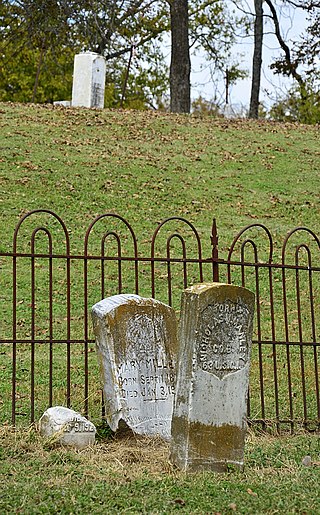
The Mound Cemetery is a historic cemetery, located just outside Arkansas City, Arkansas in Desha County. The oldest portion of the cemetery, dating to the 1860s, is located on top of a Mississippian culture mound, one of the few places the early American settlers of the area found to be safe from periodic flooding by the Mississippi River. It is located off County Road 351, about one-half mile outside Arkansas City, and about 3 miles (4.8 km) from the river.

Oakland Cemetery is a historic cemetery in Camden, Arkansas, located on Maul Road between Pearl Street and Madison Avenue. Established in 1830, it is the city's oldest cemetery. It consists of just over 7 acres (2.8 ha) of land donated in that year by William L. Bradley, one of Camden's founders. It is the burial site of many of Camden's leading citizens. Among them is James Thomas Elliott (1823–1875), a former Confederate soldier who represented Arkansas's 2nd District as a Republican.
Hampton Springs Cemetery is a cemetery in rural Dallas County, Arkansas, at the junction of county roads 425 and 427, near the city of Carthage. The cemetery is divided into two sections, one in which traditional European grave markers predominate, and another section in which graves are marked by a local adaptation of African burial customs.

Mills Cemetery is a small historic cemetery in rural Little River County, Arkansas. It is a 3.5-acre (1.4 ha) parcel of land on the north side of County Road 40, about 1/8 mile west of its junction with United States Route 71, about 2 miles (3.2 km) north of Wilton, Arkansas. It is one of the oldest cemeteries in the county, holding the graves of members of the Mills family, who first explored the Little River County area in the 1850s. The oldest of the 39 known graves dates to the 1850s; one of the most prominent burials is Joel Mills (1808–71), who was a major plantation owner.

Maple Hill Cemetery is located on Holly Street, north of the center of Helena, Arkansas. It is set on 37 acres (15 ha) of land on the east side of Crowley's Ridge, overlooking the Mississippi River, and is the city's largest cemetery. The cemetery was established in 1865, and is laid out in the rural cemetery style which was popular in the mid-19th century. It departs from the norms of this style in retaining a largely rectilinear layout despite having parklike features. The cemetery's entrance is through an elaborately-decorated wrought iron archway, whose posts were given in 1914, and whose arch was given in 1975. The largest monument in the cemetery is the Coolidge Monument, placed by Henry P. Coolidge on the family plot, which is at the highest point of section 3; the monument is a granite column 21 feet (6.4 m) in height, with a life-size sculpture of Coolidge on top.
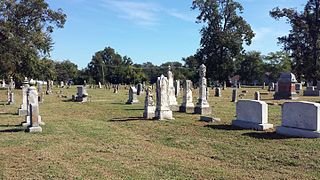
Violet Cemetery, also known as the Osceola Grave Yard, is a cemetery in Osceola, Arkansas. It is the city's oldest cemetery, with its oldest dated grave marked 1831. Many of the area's early settlers are buried here, and it is the earliest known surviving element of the early days of the area's settlement. It is located near the county courthouse, in an area bounded by West Johnson Avenue, Semmes Avenue, and Pecan Street. It is a flat, square site, flanked by trees.
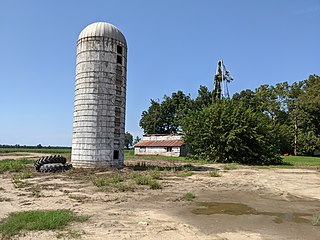
The Edward Samuel Wildy Barn is a historic barn at 1198 South Arkansas Highway 136 in rural Etowah, Arkansas. Built in 1915, it is a well-preserved example of a gambrel-roofed barn in Etowah, representative of agricultural practices of the early 20th century in Mississippi County. It is a rectangular structure, with a central component that is gambrel-roofed, and shed-roofed wings on the sides. The complex it stands in, built in 1915 by Edward Samuel Wildy, also includes from that period a windmill, silo, and concrete pads and troughs.

Fairview Cemetery, also known as the Van Buren Cemetery, is a historic cemetery on the east side of Arkansas Highway 59 in Van Buren, Arkansas. The 10-acre (4.0 ha) cemetery's oldest graves date to 1816, the period of the region's settlement, and include some of Van Buren's first settlers. First established as an informal private burial ground, it was given to the city by John Drennen in 1846.
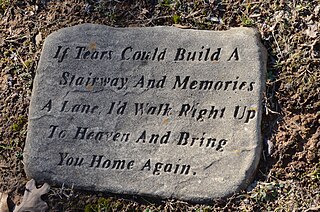
The Singleton Family Cemetery is a historic cemetery on the western outskirts of Charleston, Arkansas. Established in the 1870s, it contains more than 120 graves; approximately half of these are marked graves. It is the oldest site associated with the early formation of Charleston, and several of its earliest settlers are buried here. The most prominent grave is that of Julia Singleton Cormack, one of the community's first school teachers. The cemetery continues to be used by the Singleton family descendants.

The Hollywood Cemetery is the oldest cemetery in Hot Springs, Arkansas. The cemetery was established sometime prior to the American Civil War, with its oldest marked grave dating to 1856. It is located southeast of downtown Hot Springs, and is bounded by Hollywood Avenue, Mote Street, and Shady Grove Road. Its Confederate Section, located in the northeastern part of the cemetery, commemorates the city's Civil War Confederate Army soldiers, and contains 34 marked burials. At the center of that area is an 8-foot (2.4 m) granite monument in which is a marble marker inscribed "OUR CONFEDERATE DEAD". The Confederate section of the cemetery was listed on the National Register of Historic Places in 1996.
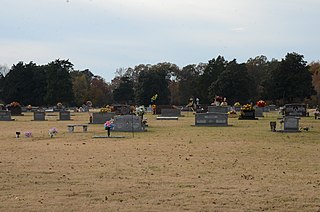
Oak Grove Cemetery is a historic cemetery on 7th Street in Des Arc, Arkansas. Established in the 1850s, it is the city's oldest cemetery, occupying about 2.5 acres (1.0 ha) now hemmed in by development. It has 182 documented historic burials, and is one of its few surviving pre-Civil War elements. Most of its interments took place before 1930, and there have been none since 1970.
The Palarm Bayou Pioneer Cemetery is a historic cemetery in a rural-suburban area of northern Pulaski County, Arkansas. It is located northwest of Maumelle, between the Arkansas River Trail and Palarm Creek, on a rise that is now part of the gated Mountain Crest residential subdivision. The small cemetery, with just ten marked graves, stands at the top of a rise north of Mt. Pilgrim Baptist Church. Nine of the graves are surrounded by a low stone wall, while one is set outside that enclosure, surrounded by a wrought iron fence. The oldest of the marked graves is that of Daniel Wilson, who died in 1837. The cemetery is probably one of the county's oldest.

Oak Grove Cemetery is the oldest cemetery of the city of Conway, Arkansas. It was established in 1880, five years after the town was incorporated and nine after its first settlement. The cemetery is in active use, with more than 3,000 burials. Among the interred are many of the city's earliest and most prominent citizens.

Brearley Cemetery, founded in 1847, is the oldest cemetery in the city of Dardanelle, Arkansas. It is located on the north side of Arkansas Highway 27, west of its junction with Arkansas Highway 22. The cemetery, still in active use, houses more than 2,000 burials, many of the descendants of the early Czech immigrants to the area. One marker, possibly a memorial marker, bears the date 1780, but its provenance and significance has not been established. A 15-acre (6.1 ha) section on the eastern side of the cemetery, where its oldest burials are located, was listed on the National Register of Historic Places in 2007.




















